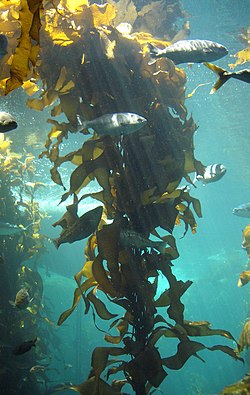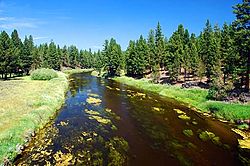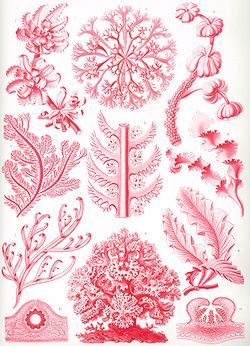Red algae, or Rhodophyta (/roʊˈdɒfɪtə/, /ˌroʊdəˈfaɪtə/; from Ancient Greek ῥόδον (rhódon) 'rose' and φυτόν (phutón) 'plant'), make up one of the oldest...
63 KB (6,312 words) - 20:07, 26 February 2025
Harmful algal bloom (redirect from Harmful algae)
A harmful algal bloom (HAB), or excessive algae growth, sometimes called a red tide in marine environments, is an algal bloom that causes negative impacts...
166 KB (18,587 words) - 05:37, 10 May 2025
Glaucophyte (redirect from Glaucophyte algæ)
the group varies from about 14 to 26. Together with the red algae (Rhodophyta) and the green algae plus land plants (Viridiplantae or Chloroplastida), they...
11 KB (987 words) - 01:39, 14 May 2025
algae,—some of which may reach 50 m in length (kelps)—the red algae, and the green algae. The most complex forms are found among the charophyte algae...
101 KB (11,845 words) - 20:12, 20 May 2025
Coralline algae are red algae in the order Corallinales. They are characterized by a thallus that is hard because of calcareous deposits contained within...
33 KB (3,666 words) - 20:41, 19 May 2025
only known fish species to consume red algae, including ‘black brush’ or ‘beard’ algae. Closely related is the red algae-eater Crossocheilus langei, a species...
7 KB (746 words) - 10:44, 16 July 2024
Brown algae (sg.: alga) are a large group of multicellular algae comprising the class Phaeophyceae. They include many seaweeds located in colder waters...
58 KB (5,875 words) - 19:19, 10 April 2025
also occurred in the red and brown algae). Diplobiontic green algae include isomorphic and heteromorphic forms. In isomorphic algae, the morphology is identical...
29 KB (2,666 words) - 05:31, 2 May 2025
one of the only fish that will graze on "black brush algae" (freshwater Rhodophyta, or red algae), but even so will eat anything else in preference. Fishes...
10 KB (947 words) - 01:18, 21 March 2025
Cyanobacteria (redirect from Blue-green algae)
photosynthesis is performed. Photoautotrophic eukaryotes such as red algae, green algae and plants perform photosynthesis in chlorophyllic organelles that...
180 KB (17,964 words) - 18:15, 19 May 2025
Snow algae are a group of freshwater micro-algae that grow in the alpine and polar regions of the Earth. Snow algae have been found on every continent...
13 KB (1,439 words) - 05:41, 23 February 2025
Edible seaweed (redirect from Culinary algae)
belong to one of several groups of multicellular algae: the red algae, green algae, and brown algae. Seaweeds are also harvested or cultivated for the...
30 KB (2,628 words) - 03:49, 21 April 2025
Dinoflagellate (redirect from Dinoflagellate algæ)
derived from secondary endosymbiosis of red algae, however dinoflagellates with plastids derived from green algae and tertiary endosymbiosis of diatoms...
103 KB (11,050 words) - 19:45, 6 May 2025
Protists in the fossil record (section Red algae)
the diatoms, golden algae, haptophytes (coccoliths), silicoflagellates, tintinnids (ciliates), dinoflagellates, green algae, red algae, heliozoans, radiolarians...
70 KB (7,735 words) - 20:07, 4 May 2025
green algae, ochrophytes, euglenophytes) to amoeboid cells (chlorarachniophytes) to colonial and multicellular macroscopic forms (e.g., red algae, some...
216 KB (23,062 words) - 13:30, 20 May 2025
cultivated within algae scrubbers. Few algae, such as marimo or red moss, are sought after for aquascaping in freshwater aquaria. Green algae respond strongly...
14 KB (1,458 words) - 01:47, 1 April 2025
Chloroplast (redirect from Red algal derived chloroplast)
membranes of the chloroplast. All secondary chloroplasts come from green and red algae. No secondary chloroplasts from glaucophytes have been observed, probably...
193 KB (19,591 words) - 05:38, 8 May 2025
edible seaweed used in Japanese cuisine, usually made from species of the red algae genus Pyropia, including P. yezoensis and P. tenera. It has a strong and...
19 KB (2,144 words) - 18:29, 4 February 2025
Marine primary production (redirect from Marine algae)
contributors to primary production in the ocean, including green algae, brown algae and red algae, and a diverse group of unicellular groups. Vascular plants...
82 KB (8,306 words) - 01:24, 27 November 2024
made of small cubes of agar jelly, a white translucent jelly made from red algae. The agar is dissolved with water (or fruit juice such as apple juice)...
2 KB (198 words) - 23:45, 21 March 2024
List of sequenced plastomes (section Red algae)
sequence and analysis of plastid genomes of two economically important red algae: Pyropia haitanensis and Pyropia yezoensis". PLOS ONE. 8 (5): e65902....
99 KB (8,120 words) - 15:36, 24 December 2024
Polysiphonia (redirect from Red hair algae)
Polysiphonia, known as red hair algae, is a genus of filamentous red algae with about 19 species on the coasts of the British Isles and about 200 species...
19 KB (819 words) - 18:21, 29 August 2024
major group of eukaryotes, comprising the photoautotrophic red algae (Rhodophyta), green algae, land plants, and the minor group glaucophytes. It also includes...
42 KB (4,163 words) - 02:29, 5 May 2025
Florideophyceae is a class of exclusively multicellular red algae. They were once thought to be the only algae to bear pit connections, but these have since been...
6 KB (482 words) - 02:10, 11 June 2024
Plastid (section In algae and protists)
1.5 billion years ago in the Archaeplastida clade—land plants, red algae, green algae and glaucophytes—probably with a cyanobiont, a symbiotic cyanobacteria...
29 KB (3,287 words) - 05:37, 8 May 2025
Pterocladiophila (category Red algae genera)
Pterocladiophila is a genus of red algae, parasite of other red algae. Fan, Kung-Chu; Papenfuss, George F. (1959). "Red Algal Parasites Occurring on Members...
615 bytes (38 words) - 23:52, 30 November 2023
in aquatic environments and is the sister group to red algae and possibly Picozoa. While red algae have no flagellated stages and are generally photoautotrophic...
8 KB (840 words) - 20:07, 26 February 2025
Maerl (also rhodolith) is a collective name for non-geniculate coralline red algae with a certain growth habit. Maerl grows at a rate of c. 1 mm per year...
16 KB (1,642 words) - 12:15, 15 October 2024
six eukaryotic lineages: animals, symbiomycotan fungi, brown algae, red algae, green algae, and land plants. Eukaryotes are grouped by genomic similarities...
63 KB (6,253 words) - 19:20, 14 May 2025
term life history is often used, particularly for organisms such as the red algae which have three multicellular stages (or more), rather than two. Life...
24 KB (2,972 words) - 15:32, 30 March 2025


























